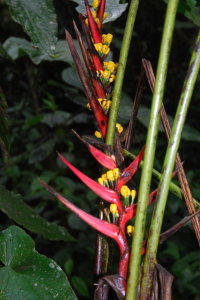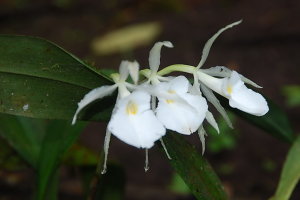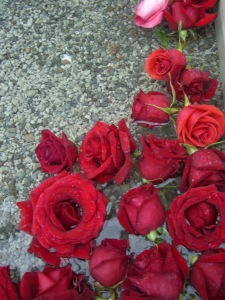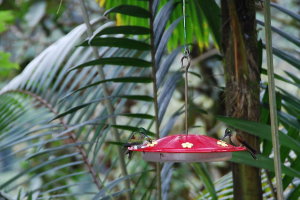 Ecuador, a country the size of Colorado built from 47 volcanos, does not know what a straight road is. Everything curves. Most roads are two lanes, if that. And to go fifty miles takes about two hours of mostly blind hairpin turns, and if the traffic isn’t terrible. (My notebooks are full of notes I cannot read because the roads were so rough. No one wants to talk about how many deaths on the road happen annually.) It’s a wild ride, Mr. Toad.
Ecuador, a country the size of Colorado built from 47 volcanos, does not know what a straight road is. Everything curves. Most roads are two lanes, if that. And to go fifty miles takes about two hours of mostly blind hairpin turns, and if the traffic isn’t terrible. (My notebooks are full of notes I cannot read because the roads were so rough. No one wants to talk about how many deaths on the road happen annually.) It’s a wild ride, Mr. Toad.
 Yet Ecuador swims with diversity and I only saw the North Andes provinces of Pinchinca (rain forest there) and Imbabura. (I missed Cotapaxi, the highest volcano on the south side of Quito.) In twenty minutes, the landscape changes from bosque to bog, selva tropica to paramos where the temperature at night drops to zero; from cathedral sized bamboo arches to silver leafed heliconia and secropia (a pioneer plant – which means it will rebirth after a fire levels it); from raining rain all around to dry rock and cactus, from lush green fields and greenhouses of roses to a tight city hugging the Andes hillsides with no room to breath where a nice apartment rents for two hundred dollars a month.
Yet Ecuador swims with diversity and I only saw the North Andes provinces of Pinchinca (rain forest there) and Imbabura. (I missed Cotapaxi, the highest volcano on the south side of Quito.) In twenty minutes, the landscape changes from bosque to bog, selva tropica to paramos where the temperature at night drops to zero; from cathedral sized bamboo arches to silver leafed heliconia and secropia (a pioneer plant – which means it will rebirth after a fire levels it); from raining rain all around to dry rock and cactus, from lush green fields and greenhouses of roses to a tight city hugging the Andes hillsides with no room to breath where a nice apartment rents for two hundred dollars a month.
 Pollution is powerful as you lift from 3000 feet to 8000 feet and even 12,000 feet and don’t even know it except air seems a bit short. Every kind of bromeliad and/or orchid cover just about every semblance of a tree, alive or dead. Elephant ears (philodendrons) are larger than grand piano tops and make group umbrellas. I even saw one producing a giant white flower. Green orchids camouflage themselves beside bright passion flowers and fruit, well, the fruit is extraordinary. But what you really should be to appreciate Ecuador is a bird watcher. I’m not one of those.
Pollution is powerful as you lift from 3000 feet to 8000 feet and even 12,000 feet and don’t even know it except air seems a bit short. Every kind of bromeliad and/or orchid cover just about every semblance of a tree, alive or dead. Elephant ears (philodendrons) are larger than grand piano tops and make group umbrellas. I even saw one producing a giant white flower. Green orchids camouflage themselves beside bright passion flowers and fruit, well, the fruit is extraordinary. But what you really should be to appreciate Ecuador is a bird watcher. I’m not one of those.
 Not only does the environment change every two or so miles, but so does the food and the make up of the people. Many tribes of indigenous Indians continue to survive – and tell you point blank they are NOT Incas, who as invaders from Peru in history exploited Ecuador’s culture (I spent a moment praying at the ornate baroque church, La Compania de Jesus, built in 1605, and completely bathed in seven tons of gold leaf. It is a remnant of Inca wealth.) There is as well a large colony of resident Africans who swam ashore in 1620 when a Peruvian slave ship sank on the north coast, and those who were able to swim ashore and survive formed a colony near the beach keeping sacred African traditions.
Not only does the environment change every two or so miles, but so does the food and the make up of the people. Many tribes of indigenous Indians continue to survive – and tell you point blank they are NOT Incas, who as invaders from Peru in history exploited Ecuador’s culture (I spent a moment praying at the ornate baroque church, La Compania de Jesus, built in 1605, and completely bathed in seven tons of gold leaf. It is a remnant of Inca wealth.) There is as well a large colony of resident Africans who swam ashore in 1620 when a Peruvian slave ship sank on the north coast, and those who were able to swim ashore and survive formed a colony near the beach keeping sacred African traditions.
The selling points as Ecuador buffs up its tourist trade to focus on more than just Galapagos is i ts variety. There are more species of hummingbirds (picaflor or colibries) than anyone has ever seen anywhere else, more rare orchids, more tropical plants found no where else, even hallucinogens that look like oranges and are called uvre de vaca (cow udder). More than seventy five percent of the world’s chocolate (cacao) is produced (grown) in Ecuador and yet it’s almost impossible to buy a candy bar of pure Ecuadorian chocolate. It is all exported to Belgium, France, Switzerland, the countries that make the best chocolate in the world.
ts variety. There are more species of hummingbirds (picaflor or colibries) than anyone has ever seen anywhere else, more rare orchids, more tropical plants found no where else, even hallucinogens that look like oranges and are called uvre de vaca (cow udder). More than seventy five percent of the world’s chocolate (cacao) is produced (grown) in Ecuador and yet it’s almost impossible to buy a candy bar of pure Ecuadorian chocolate. It is all exported to Belgium, France, Switzerland, the countries that make the best chocolate in the world.
 Roses – aah – the exportation of long stem hot house roses is a major industry in Ecuador. Ten million acres are covered with green houses producing the best roses in the world, exporting more than Colombia who actually grow more roses. These roses appear in our supermarkets overnight. (Cheers to FedEx). One guide explained that major buyers are the USA, Russia and Europe and each has its own specific requirements: the USA demands no thorns, big rose heads, tightly shut, 40 cm. stems and few leaves. Europeans want small rose heads, slightly opened, big, long stems, many leaves and ok on the thorns. The Russians and Ukranians, who buy four to five times more than the USA to brighten up continually freezing climates, want everything in abundance: long stems, lots of leaves, thorns, and rose heads completely opened.
Roses – aah – the exportation of long stem hot house roses is a major industry in Ecuador. Ten million acres are covered with green houses producing the best roses in the world, exporting more than Colombia who actually grow more roses. These roses appear in our supermarkets overnight. (Cheers to FedEx). One guide explained that major buyers are the USA, Russia and Europe and each has its own specific requirements: the USA demands no thorns, big rose heads, tightly shut, 40 cm. stems and few leaves. Europeans want small rose heads, slightly opened, big, long stems, many leaves and ok on the thorns. The Russians and Ukranians, who buy four to five times more than the USA to brighten up continually freezing climates, want everything in abundance: long stems, lots of leaves, thorns, and rose heads completely opened.
A Chocolate-Fragrant Orchid
 Each rose ranch employs about one hundred, and eighty per cent are women, who work from 7 a.m. until 3 p.m. while kids are in school. But the ranches offer day care and many extras. These are called Floricolas. Actually women have it pretty good in Ecuador. Those at home are expected to cook for breakfast and lunch, but dinner is a left-over hodgepodge. The saying goes: breakfast fit for a prince, lunch fit for a king, and dinner fit for a pauper. Best, women are given a day off every week from household cooking and chores. It’s tradition. Men don’t cook at home or over the barbecue pit as they do in Uruguay and Argentina. Beef isn’t terrific in Ecuador. Fish is. The star of most meals is tasty cerviche, a deep bowl of tomato and onion broth filled with seafood, squid, corvina and onions, always accompanied by side bowls of popcorn and fried corn kernals. Soups of all kind are festive lead-ins to most mid-day meals, especially locros de papas (a potato, cheese and avocado soup.)
Each rose ranch employs about one hundred, and eighty per cent are women, who work from 7 a.m. until 3 p.m. while kids are in school. But the ranches offer day care and many extras. These are called Floricolas. Actually women have it pretty good in Ecuador. Those at home are expected to cook for breakfast and lunch, but dinner is a left-over hodgepodge. The saying goes: breakfast fit for a prince, lunch fit for a king, and dinner fit for a pauper. Best, women are given a day off every week from household cooking and chores. It’s tradition. Men don’t cook at home or over the barbecue pit as they do in Uruguay and Argentina. Beef isn’t terrific in Ecuador. Fish is. The star of most meals is tasty cerviche, a deep bowl of tomato and onion broth filled with seafood, squid, corvina and onions, always accompanied by side bowls of popcorn and fried corn kernals. Soups of all kind are festive lead-ins to most mid-day meals, especially locros de papas (a potato, cheese and avocado soup.)
The reason Ecuador can is a haven for rose production is that, being on the equator, plants are guaranteed twelve hours a day of sunshine, varying hardly at all during the year (rose ranches are right on the equator) and this produces stems that grow straight up to the sun, although I saw only cloud and rain in my four nights there. Our own Memphis cultured garden roses, wonderfully odorous, colorful and growing in every direction, are less precise or repetitive. The Ecuadorian rosarians spend much time creating new colors and stiff thornless stems to satisfy international markets. Giant bouquets of rose heads decorate counters at the airport, restrooms, to spa pools (floating roses). Petals are sprinkled over your bed, in romantic patterns and a single red rose is often stuck in the complimentary guest robes, but sadly none have fragrances like Old English roses. If I can select a best desert on this adventure, it was the one at Le Mirage Hotel in Ecuador: tiny balls of rose sorbet lounging o n rose petals which had been sugared and quickly fried to resembled meringue. Talk about gustatory delight!


